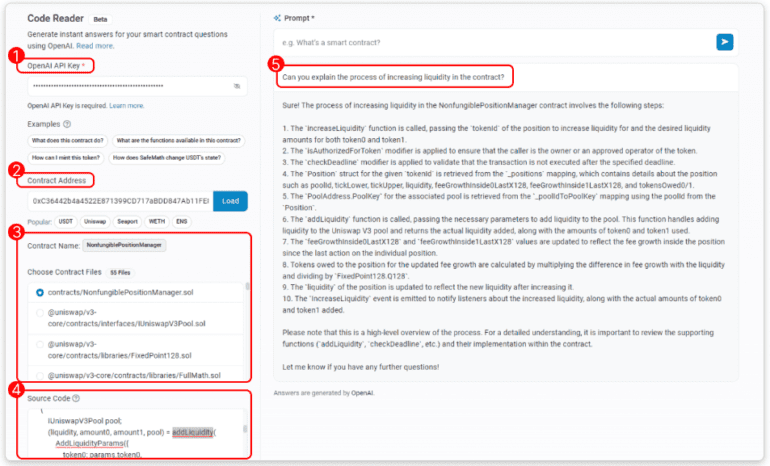TL;DR:
- Etherscan introduces Code Reader, a tool powered by OpenAI’s large language model (LLM) for researching solidity smart contracts.
- Code Reader enables non-developers to understand the functionality of specific smart contracts and interact with them.
- Professional auditing firms are finding Code Reader to be a valuable productivity boost.
- The feature aids developers in integrating smart contracts into their decentralized applications using natural language.
- Code Reader has limitations but provides detailed insights into smart contract code, as demonstrated by analyzing the PEPE token contract.
- Etherscan is actively seeking user feedback to improve Code Reader’s capabilities.
- The tool democratizes smart contract analysis and has significant implications for the market.
Main AI News:
In a groundbreaking move for the Ethereum community, Etherscan, the leading block explorer and analytics platform, has unveiled an innovative tool called Code Reader. Leveraging the power of OpenAI’s cutting-edge large language model (LLM), this beta feature enables individuals with limited programming expertise to delve into the intricacies of solidity smart contracts.
Just as Etherscan’s Advanced Filter streamlines transaction research, Code Reader empowers non-developers by providing an intuitive means to comprehend the inner workings of specific smart contracts. By utilizing OpenAI’s LLM, users gain valuable insights into contract functionality, bridging the knowledge gap and making Ethereum’s smart contract landscape more accessible than ever before.
It is important to note that the answers provided by Code Reader originate from OpenAI’s LLM rather than Etherscan itself. While the tool has proven useful in writing and parsing code, it is crucial not to rely solely on its outputs. Etherscan emphasizes that Code Reader should be used in conjunction with other resources and professional expertise to ensure accurate and reliable analysis.
Early adopters have already hailed Code Reader for its remarkable productivity boost. Security solutions architect Michael Lewellen from OpenZeppelin expressed his satisfaction, stating, “I’ve found it very useful. It has greatly enhanced the user experience, and I’ve thoroughly enjoyed utilizing it.“
Real-world Applications
Etherscan highlights the myriad use cases for this feature, especially in aiding developers and other interested parties in understanding code better. For those interacting with a smart contract for the first time, Code Reader offers a comprehensive understanding of its operations and functionality. By entering a smart contract address, users can swiftly access a list of functions associated with the contract. This invaluable information not only facilitates direct interaction with the smart contract but also provides an alternative approach to utilizing a front-end interface.
Experienced developers can leverage Code Reader to explore how a particular smart contract can be integrated into their decentralized applications using natural language commands. This opens up new possibilities for seamless integration and promotes greater adoption of Ethereum-based technologies.
The Limitations of PEPE
While Code Reader excels in breaking down smart contract code, it is important to acknowledge its limitations. It cannot shed light on the utility of memes or determine the value of tokens within their respective communities. However, it can delve into the intricate details of a given smart contract, as demonstrated by an analysis of the popular memecoin PEPE’s token contract.
A cursory glance at the PEPE token page reveals its substantial popularity, with approximately 121,000 holders and a fully diluted market cap exceeding $600 million. The contract itself possesses the “ownable” attribute, granting exclusive access to specific functions to the designated account owner. These functions include the ability to transfer ownership, establish rules for token transfers, manage a blacklist of addresses, and renounce ownership to remove exclusive functionalities.
Renouncing ownership of a contract relinquishes control over its state and administrative actions, as explained by the Code Reader. Once ownership is renounced, the contract loses the ability to modify the blacklist, rendering it unable to restrict transfers by adding addresses. Consequently, PEPE transactions can occur freely without the risk of censorship, although other functionalities remain limited.
Ongoing Development and Feedback
Code Reader represents an exciting development in smart contract analysis, yet it is important to note that the feature is still in development. The Etherscan team actively seeks user feedback to refine and enhance its capabilities further. Utilizing the Code Reader tool requires an OpenAI API key, along with sufficient credits, demonstrating Etherscan’s commitment to continuously improve and provide users with a robust and reliable experience.
With Code Reader, Etherscan and OpenAI are democratizing access to smart contract analysis, allowing individuals without extensive programming backgrounds to navigate Ethereum’s complex ecosystem confidently. As this tool continues to evolve, the Ethereum community eagerly anticipates the myriad possibilities it will unlock for developers, auditors, and enthusiasts alike.
Conclusion:
The introduction of Code Reader by Etherscan, powered by OpenAI, marks a significant milestone in smart contract analysis. By enabling non-developers to understand and interact with smart contracts, the tool enhances accessibility and fosters innovation within the Ethereum ecosystem. Its potential benefits extend to developers, auditors, and other interested parties, empowering them to harness the full potential of smart contracts in their applications. As Code Reader continues to evolve, it will likely drive further growth and adoption of Ethereum-based technologies, revolutionizing the market dynamics and opening new opportunities for decentralized solutions.

